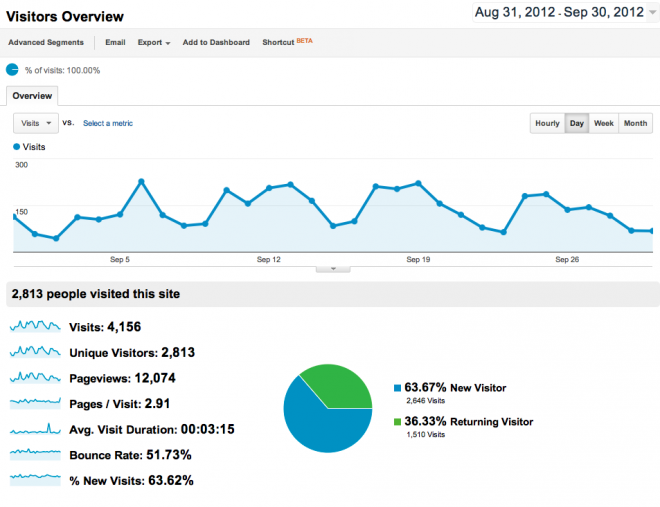Find Out How Much Traffic Your Restaurant Website Gets (& More Insights)
 Do you know how many people visit your restaurant’s website? How about knowing where your traffic is coming from?
Do you know how many people visit your restaurant’s website? How about knowing where your traffic is coming from?
If you want to get serious about using your website to attracting more customers to your restaurant, you must first understand how much traffic your website receives. This article will show just how easy it is to obtain this information (and much more).
Oh, and did I mention, you can gain all of these traffic insights for free?! Yup… read on:
Introducing: Google Analytics for Restaurant Websites
Restaurant operators, say hello to Google Analytics.
It’s a free tool from Google, that allows any website owner to gain a tremendous amount of insights about the traffic that their website receives. All you need is a Google Account (have a GMail account? You’re good.) and you’re already registered to use Google Analytics.
More on how to setup Google Analytics for your restaurant later in this article. But first…
What Does Google Analytics Do?
There are loads of insights that Google Analytics allows you, the website owner, to gain access to. In this article, we’ll just scratch the surface and give you the “essentials”.
Here are three key insights Google Analytics gives restaurant owners:
1. Traffic Stats
“How many people see my website?”
At it’s core, Google Analytics tells you how much traffic your website receives, and it breaks it down by day, week, month, and year. So you can see which days of the week are most visitors hitting your website or which months of the year see the most activity.
Why it’s useful to your restaurant: You could offer special coupons on your website on certain days or months to help you capitalize on the influx of traffic you receive at those times. Or simply know when it is most important to post your latest menu updates for all to see.
2. Traffic Sources
“How do people find out about my website?”
Just knowing how many people see your website doesn’t give you any “actionable” intelligence. In order to use this info to our advantage, we must found out where our traffic is coming from. Google Analytics shows you:
- Which websites link to your website and how many visitors do they send your way
- How much traffic finds us through Google Search (and which keywords are they typing into Google that eventually lead them to your website)
- How many people type in your website address directly into their web browser
“Nurture the key sources of traffic to attract even more visits and customers to your restaurant.”
Tweet This
Why it’s useful to your restaurant: By knowing which websites are sending you traffic, you know where should be investing your time and energy to nurture those traffic sources. For example, many restaurants will see “yelp.com” as one of their top sources of traffic. If that’s the case for your restaurant website, then you know you should make sure your Yelp profile is as strong as it could be and you’re monitoring all of the reviews you get (for more see our article about marketing your restaurant on Yelp).
3. Your Most Popular Pages
“Which pages on my website receive the most traffic?”
Your next key insight is to know what your visitors are doing after they’re on your website. Which pages on your website capture your visitor’s attention? Which pages are being ignored? Google Analytics shows you a list of the “top ten” pages on your website that receive the most traffic.
Why it’s useful to your restaurant: When you know which pages and content attract the most attention from your visitors, you can leverage that and create even more interest. Find out what works, and do more of that! For example, you might find your food menu page gets a lot of traffic. Then you’ll know that it pays to ensure this page is always up to date, and easy for your visitors to access. Did you write a blog entry that’s receiving more traffic than others? Now you know you’ve hit on a topic your visitors care about. Write more articles around that topic and you’ll attract even more traffic and interest.
How to Add Google Analytics to Your Restaurant Website
Enough talk. Let’s put this into action!
Follow these steps to setup Google Analytics and you’ll be collecting traffic information for your Restaurant’s website in no time…
1. Open Your Google Analytics Account
 Go to google.com/analytics. If you already have a Google account, click “Sign In”. If not, click “Create an account”. If you already use Gmail, then you already have a Google account. Use your Gmail credentials to log in.
Go to google.com/analytics. If you already have a Google account, click “Sign In”. If not, click “Create an account”. If you already use Gmail, then you already have a Google account. Use your Gmail credentials to log in.
2. Obtain Your Tracking Code
![]() Once logged into Google Analytics, you will create your first “property” or website, which you want to track. At this point, you will be provided with a tracking code, which you are instructed to copy and paste into your website. Now, this is somewhat technical and usually requires editing your website files.
Once logged into Google Analytics, you will create your first “property” or website, which you want to track. At this point, you will be provided with a tracking code, which you are instructed to copy and paste into your website. Now, this is somewhat technical and usually requires editing your website files.
However, if you have a website from Restaurant Engine, we make this party very easy. Just paste your Google Analytics tracking code in the box that we provide within your website dashboard. Save, and you’re done!
3. Start collecting traffic data
Now that your Google Analytics tracking code is in place on your website, you’re now collecting traffic data. Just log into your Google Analytics account to start seeing your traffic reports. It will usually take roughly 24 hours before you’ll be able to see any data reported in your Google Analytics account.

More Traffic, More Customers
The bottom line is this: The more traffic your restaurant website receives, the more visitors that will become customers of your restaurant (and more people to spread word-of-mouth recommendations and so on). But before you can build that traffic, you must understand that traffic. This is where Google Analytics comes into play for your restaurant.
It’s a simple, zero-cost tool that can be implemented right now on your website. So don’t delay! Setup your Google Analytics and find out how much traffic your restaurant website is getting.
Have questions or want to explore this further? Leave a comment or tweet to us!

Leave a Reply